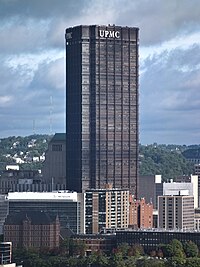 | |
 U.S. Steel Tower in Pittsburgh | |
| Formerly | USX Corporation (1986–2001) |
|---|---|
| Company type | Public |
| NYSE: X S&P 400 Component | |
| Industry | Steel Industrial manufacturing |
| Founded | March 2, 1901 by merger of Carnegie Steel with Federal Steel Company & the National Steel Company |
| Founders | |
| Headquarters | U.S. Steel Tower Pittsburgh, Pennsylvania, US |
Area served | Worldwide |
Key people | |
| Products | Flat-rolled steel Tubular steel Iron ore |
| Revenue | |
| Total assets | |
| Total equity | |
Number of employees | 21,803[6] (2023) |
| Website | ussteel.com |
United States Steel Corporation, more commonly known as U.S. Steel, is an American integrated steel producer headquartered in Pittsburgh, Pennsylvania, with production operations primarily in the United States of America and in Central Europe. The company produces and sells steel products, including flat-rolled and tubular products for customers in industries across automotive, construction, consumer, electrical, industrial equipment, distribution, and energy. Operations also include iron ore and coke production facilities.[7]
It was the eighth-largest steel producer in the world in 2008. By 2022, the company was the world's 24th-largest steel producer and the second-largest in the United States behind Nucor Corporation. Though renamed USX Corporation in 1986, the company was renamed United States Steel in 2001 after spinning off its energy business, including Marathon Oil, and other assets, from its core steel concern.
Pending regulatory and shareholder approval, U.S. Steel would be acquired by Nippon Steel, Japan's largest steel producing company, for US$14.1 billion. The deal, announced in mid-December 2023, would retain U.S. Steel's name and headquarters in Pittsburgh. It was opposed by the United Steelworkers,[8] the Trump campaign,[9] and the Biden administration.[10][11] As of November 2024[update], the Biden administration was still set on blocking the proposed acquisition.[12]
- ^ Vivian 2020, p. 24.
- ^ Warren 1996, p. 298.
- ^ Churella, Albert J. (2012). The Pennsylvania Railroad, Volume 1: Building an Empire, 1846–1917. Philadelphia, Pennsylvania: University of Pennsylvania Press. p. 570. ISBN 978-0-8122-4348-2.
[Henry Clay] Frick had also been one of the founding directors of U.S. Steel, and he remained closely associated with that company...
- ^ Chernow 1999, pp. 389–391.
- ^ Chernow 1999, p. 393.
- ^ a b c d e f Corporation, United States Steel (2 February 2024). "U.S. STEEL ANNUAL REPORT PURSUANT TO SECTION 13 OR 15(d) OF THE SECURITIES EXCHANGE ACT OF 1934 (2023)" (PDF). Retrieved 13 February 2024.
- ^ "United States Steel Corp, X:NYQ profile - FT.com". markets.ft.com. Retrieved 2023-07-05.
- ^ Cite error: The named reference
uswopposeswas invoked but never defined (see the help page). - ^ Cite error: The named reference
:0was invoked but never defined (see the help page). - ^ Duehren, Andrew; Tita, Bob (March 14, 2024). "Biden Opposition to Takeover of U.S. Steel Comes After Months of Lobbying". Wall Street Journal. Retrieved March 15, 2024.
- ^ Cite error: The named reference
mccallstateswas invoked but never defined (see the help page). - ^ Alexander, Peter; Wile, Rob; Yamamoto, Arata (September 5, 2024). "Biden preparing to block U.S. Steel sale to Japanese company". NBC News. Retrieved October 21, 2024.
Cite error: There are <ref group=lower-alpha> tags or {{efn}} templates on this page, but the references will not show without a {{reflist|group=lower-alpha}} template or {{notelist}} template (see the help page).